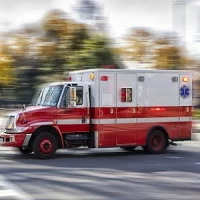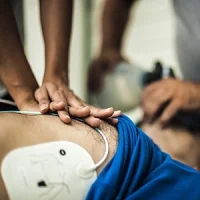A new U.S. study shows that coordinated, multifaceted public health initiatives may be helpful for communities aiming to improve outcomes of out-of-hospital cardiac arrest (OHCA), including at home. Implementation of such initiatives targeting multiple personnel across the cardiac arrest “chain of survival” resulted in more patients receiving bystander cardiopulmonary resuscitation (CPR) and first-responder defibrillation at home and in public, which was associated with improved survival, according to the study published by JAMA.
This observational study reviewed 8,269 patients with OHCAs for whom resuscitation was attempted using data from the Cardiac Arrest Registry to Enhance Survival (CARES) from 1 January 2010 through 31 December 2014. The setting was 16 counties in North Carolina. Public health initiatives to improve bystander and first-responder interventions included training members of the general population in CPR and in the use of automated external defibrillators, teaching first responders about team-based CPR (e.g., automated external defibrillator use and high-performance CPR), and instructing despatch centres on recognition of cardiac arrest.
Patients were stratified by home versus public OHCA. Among home OHCA patients (n = 5,602), the median age was 64 years, and 62.2% were male; among public OHCA patients (n = 2,667), the median age was 68 years, and 61.5% were male. After comprehensive public health initiatives, the proportion of patients receiving bystander CPR increased at home (from 28.3% [275 of 973] to 41.3% [498 of 1206], P < .001) and in public (from 61.0% [275 of 451] to 70.5% [424 of 601], P = .01), while first-responder defibrillation increased at home (from 42.2% [132 of 313] to 50.8% [212 of 417], P = .02) but not significantly in public (from 33.1% [58 of 175] to 37.8% [93 of 246], P = .17).
Other findings include:
- Survival to discharge improved for arrests at home (from 5.7% [60 of 1057] to 8.1% [100 of 1238], P = .047) and in public (from 10.8% [50 of 464] to 16.2% [98 of 604], P = .04).
- Patients with home OHCA were significantly more likely to survive to hospital discharge if they received bystander-initiated CPR and first-responder defibrillation (odds ratio, 1.55; 95% CI, 1.01-2.38).
- Patients with arrests in public were most likely to survive if they received both bystander-initiated CPR and defibrillation (odds ratio, 4.33; 95% CI, 2.11-8.87).
Although most OHCAs occur at home, historical outcomes have been significantly worse compared with public OHCAs, according to the researchers. The study finding has increased urgency to identify strategies for improving survival among these particularly vulnerable patients.
"Our data indicate that coordinated, multifaceted public health initiatives targeting multiple personnel across the cardiac arrest “chain of survival,” including first-responder programmes, are associated with improved outcomes among individuals with at-home OHCA. This result occurs despite concerns that such initiatives were not previously associated with improved survival for at-home OHCA," the authors write.
The authors add: "We also extend prior findings to a mixed rural and urban population in the United States with multiple EMS [emergency medical services] agencies and demonstrate that the combination of bystander CPR and first-responder defibrillation at home is significantly associated with improved favourable neurological survival."
Source: JAMA
Image Credit: Pixabay
Latest Articles
cardiopulmonary resuscitation, out-of-hospital cardiac arrest, Public health initiatives, first-responder defibrillation
A new U.S. study shows that coordinated, multifaceted public health initiatives may be helpful for communities aiming to improve outcomes of out-of-hospital cardiac arrest (OHCA), including at home. Implementation of such initiatives targeting multiple pe










